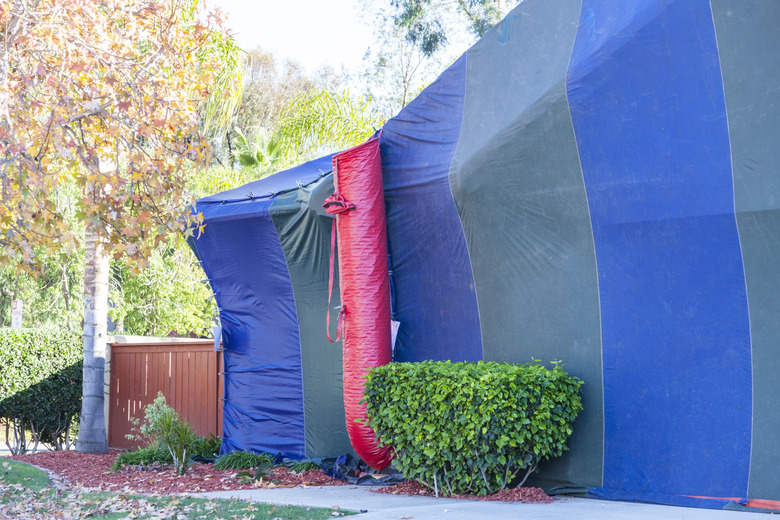What Are The Dangers Of Termite Tenting A House?
House tenting, otherwise known as "structural fumigation," is a localized method of pest control that is commonly used when other forms of pest removal would be untenable. In some instances, tenting can be used in homes, businesses and other structures to remove beetles, bed bugs and termites. Before choosing to use tenting in your home or office, there are some things that should be considered, however, as this method of pest control can prove fatal to humans, pets or plants if proper precautions are not taken.
Termite Tenting Overview
Termite Tenting Overview
During termite tenting, the occupants of the home, including plants and pets, must find somewhere else to live for two to three days due to fumigation dangers. Pest control professionals drape the house in heavy sheets of vinyl-coated nylon tarps, then secure these with tape and plastic sheeting to form a tent around the home. They pump the tent full of gaseous chemicals, which kill termites, as well as virtually any other living thing within the home.
While methyl bromide once served as the primary chemical for termite tenting, it has been phased out in favor of odorless, colorless sulfuryl fluoride. The sulfuryl fluoride is mixed with chloropicrin, a form of tear gas, which helps warn anyone who comes near the house that a dangerous chemical is present. When the tent is removed, both of these chemicals escape into the atmosphere, and the pest control professionals test the air before allowing the homeowners to move back in.
Health Effects of Tenting
Health Effects of Tenting
Sulfuryl fluoride is a central nervous system depressant, and is highly toxic to humans, animals and plants. While remaining in the home during termite tenting means certain death for animals, humans and plants, sulfuryl fluoride rapidly dissipates once the tent is removed from the home. The building and the materials within do not retain toxic levels of this chemical.
Levels of the gas decline to near undetectable levels, even without the use of fans, open doors or open windows, once the tent is removed. When termite tenting is performed properly, occupants are not cleared to re-enter the home until levels have reached below 1 part per million (PPM), a level set by the U.S. Environmental Protection Agency.
Environmental Dangers
Environmental Dangers
When the tent is removed from a home, sulfuryl fluoride rapidly escapes from the home. Though this gas no longer poses an immediate threat to the home's occupants, it does pose certain dangers to the environment. Sulfuryl fluoride is a potent greenhouse gas, and contributes to global warming. This gas stays in the atmosphere for 30 to 40 years, and may linger for as long as a century. Even worse, this gas is 4,000 percent more effective than carbon dioxide when it comes to trapping heat, which could contribute to climate change.
Is Fumigation Safe for Humans?
Is Fumigation Safe for Humans?
Fumigation is safe provided you follow all instructions given. Deaths associated with tenting are extremely rare. It is important to remember that death can happen if you re-enter your home before the air is properly tested for safety. To ensure that your family will be safe, make sure that you have the assurance that the air quality has been tested and chemical levels are below 1 PPM.
Despite the environmental risks, sulfuryl fluoride is one of the most effective ways to kill termites that could otherwise destroy your home. Severe, widespread infestations of dry wood termites and other wood-eating bugs tend to require tenting to completely kill off the infestation.
The best way to ensure that you approach termite tenting safely is to follow all instructions given by your pest removal professional. In some cases, this could mean finding a temporary residence for a few days to a week or more. The professionals will secure tarps around your home before pumping gas into the makeshift "tent." Many times, the sulfuryl fluoride is mixed with a form of tear gas known as chloropicrin. This is a precautionary measure to caution people from getting too close to the building while it is being fumigated.
